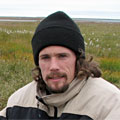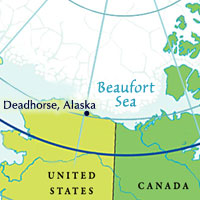Starting at the End of the Road
DEADHORSE, ALASKA– When I began thinking about logistics for this project, one of the first questions I had was “How do you get to the Arctic?” I had done field work in wildnerness areas before, but nothing as remote as northern Alaska. For our first season on capturing polar bears – August of 2008 – and much of the ensuing work we were based out of the town of Deadhorse, Alaska, otherwise known as Prudhoe Bay.
Deadhorse sits at the north end of the Dalton Highway, also called “the haul road.” From my understanding, this highway was built as a service road for the Trans-Alaskan Pipeline, which runs from the oilfields of Prudhoe Bay to Valdez where the oil is loaded onto ships. The Dalton Highway parallels the pipeline for much of its long, winding journey. The highway was opened to the public in the 1990s, although it is still mostly gravel and rough driving. The highway begins here in Deadhorse, where I drove past it today on my way to the general store.
However, we would not be driving to Deadhorse – we have done all of traveling by plane. Alaska Airlines flies to Deadhorse from Anchorage and Fairbanks, and many oil companies have private flights for their workers. The surprising accessibility of Deadhorse – if you are willing to spend days in a capable vehicle or willing to buy an expensive plane ticket – must be due to its role in oil extraction in the Prudhoe Bay oil fields. The town itself feels like a giant construction site. All buildings sit on elevated gravel pads, about eight feet above the tundra. Trucks and heavy machinery are everywhere, and equipment is constantly rumbling.
More accurately, the town feels like a cross between a construction site and a lunar module. Everything is built to withstand the fierce winter weather, with windchills that can fall below -100 Fahrenheit. Most buildings seem to have been built for ease of transport and assembly – many buildings are actually a series of connected, insulated trailers.
Our research team was up here last August for our first season of polar bear captures. We caught almost 30 bears (this includes adults and cubs) for measurements. Some adult bears received a GPS satellite collar as well. We tracked these bears via satellite during September. We returned in October and recaptured as many of these bears as possible, to re-examine them and see how they had changed during the intervening 1-2 months. This spring we are beginning another capture season – our first day of captures, weather permitting, will be Monday, April 20th.













The photos are fascinating; makes me cold just to look at all of the ice and snow.
Hi.. im the owner of the plate behind the deadhorse sign.
I love to see it there. I love Alaska.
http://www.alaskaacaballo.com.ar
see you
Gabriel